Kahuzi-Biega National Park lies near the border between Rwanda and the Democratic Republic of Congo next to Lake Kivu in the town of Bakavu. Kahuzi Biega is one of the largest national parks in Congo and was established in 1970 by Belgian wildlife conservationist and photographer Adrien Deschryver. Because of its vast rainforest and unique species of mammals, the park has been a UNESCO World heritage site since the 1980’s.
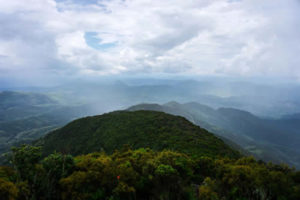 The name Kahuz-Biega is got from two dormant volcanoes found around the park edges – Mount Biega and Mount Kahuzi. The park measures about 6,000 sq km and is located in an area consisting of lowland terrain and mountains. Kahuzi-Biega National Park is home to the rare Eastern lowland gorillas (Grauer’s gorillas) which have been declared endangered by the IUCN. Grauer’s gorillas are the largest sub-species of gorillas. By 2015, it is estimated that 3,800 Eastern lowland gorillas are left living in only two national parks – Kahuzi Biega and Salonga National Park in Central Africa.
The name Kahuz-Biega is got from two dormant volcanoes found around the park edges – Mount Biega and Mount Kahuzi. The park measures about 6,000 sq km and is located in an area consisting of lowland terrain and mountains. Kahuzi-Biega National Park is home to the rare Eastern lowland gorillas (Grauer’s gorillas) which have been declared endangered by the IUCN. Grauer’s gorillas are the largest sub-species of gorillas. By 2015, it is estimated that 3,800 Eastern lowland gorillas are left living in only two national parks – Kahuzi Biega and Salonga National Park in Central Africa.
Kahuzi-Biega started as a forest and zoological reserve in 1937 under colonial rule by the Belgian government before further expansions were made to include all the surrounding vast forests, lowland areas and swamps that were home to the Grauer’s gorillas. About 137 species of mammals and 350 of birds have been recorded living on the Parks Mountains, forest floors, marshlands and vast swamps. The Eastern lowland gorilla is the most sought out mammal in the park. Lowland gorillas are found in two sectors of Kahuzi Biega National Park – The highlands and the lowlands. About 170 individuals have been recorded in the highlands. Estimating the number of individuals in the lowland areas of the park 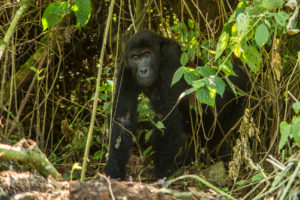 has been difficult because rebels/militias still roam that section. Their overall numbers in central Africa pale in comparison to their cousins the western lowland gorillas (over 360,000) and mountain gorillas (slightly above 1,000). Other primates in the park include the Angolan Black Monkeys, golden monkeys, Bosman’s potto, chimpanzees, Dent’s Mona, red tailed monkeys and the owl-faced monkey. The park has bongos, forest hogs, bush buffalo, bush elephant, eastern needle-clawed galago, hylochere, Maclaud’s horseshoe bat and several antelope species. Mammal species endemic to the area include the Alexander’s bush squirrel, Aquatic civet, eastern needle-clawed galago, giant gennet, Maclaud’s horseshoe bat, Ruwenzori least otter shrew, Thomas’ tree squirrel and the mount kahuzi climbing mouse. Birders should look out for endemic species like the Grauer’s broadbill, Grauer’s warbler, Rockefeller’s sunbird and Shelley’s crimsonwing.
has been difficult because rebels/militias still roam that section. Their overall numbers in central Africa pale in comparison to their cousins the western lowland gorillas (over 360,000) and mountain gorillas (slightly above 1,000). Other primates in the park include the Angolan Black Monkeys, golden monkeys, Bosman’s potto, chimpanzees, Dent’s Mona, red tailed monkeys and the owl-faced monkey. The park has bongos, forest hogs, bush buffalo, bush elephant, eastern needle-clawed galago, hylochere, Maclaud’s horseshoe bat and several antelope species. Mammal species endemic to the area include the Alexander’s bush squirrel, Aquatic civet, eastern needle-clawed galago, giant gennet, Maclaud’s horseshoe bat, Ruwenzori least otter shrew, Thomas’ tree squirrel and the mount kahuzi climbing mouse. Birders should look out for endemic species like the Grauer’s broadbill, Grauer’s warbler, Rockefeller’s sunbird and Shelley’s crimsonwing.
The park is managed by the Congolese Institute of Conservation of the Nature (ICCN) in collaboration with the Congolese government and with support from international wildlife conservation organizations like the Wildlife Conservation Society (WCS) and the World Wildlife Fund (WWF). The challenges faced by these key actors in maintaining the great biodiversity and particularly the vegetation are fourfold. One is the volatile situation in the Eastern part of DR Congo and the presence of militias and other rebel element in the lowland section of the park. Political instability within Congo and nearby Rwanda between 1996 and 2003 was very difficult for the park animals. The country received a large number of refugees from Rwanda who occupied large chunks of land in the park clearing forests and animals like the Grauer’s Gorillas. A second challenge comes from the local population living within or near the park. Kahuzi-Biega National park is found in one of DR Congo’s most densely populated area with tribes like the Barega, Bashi and pygmies living within or outside the park. 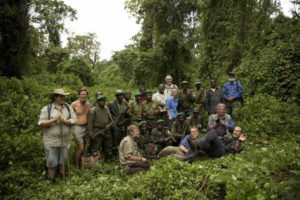 Trees and other forest vegetation have been lost to illegal logging, which has led to fragmentation of the number of larger mammals in some parts of the park. A park that covers 2,316 sq miles of dense jungle is difficult to secure. Some sectors of the park are still occupied by subsistence farmers. The government and park management have taken significant steps to curb poaching and encroachment on park land while also resolving disputes with local tribes who had been evicted during the 1975 expansion of the park. The park management has improved park border patrols, earmarked park demarcations and carried out community sensitization about the importance of the wildlife for posterity. The park employs the local people who were evicted from the park and former poachers. Community leaders have been actively involved in the management of the park to create a sense of ownership and joint responsibility for conservation of the park resources. Gorilla tourism in particular has benefited the locals by raising their incomes through selling food and souvenir to the hotels and tourists respectively. The third challenge is a significant shortage of funding due to the poor economy that has often led to under-staffing. The park management has taken significant steps to attract funding by setting up A Trust Fund targeting generous individuals and organization. The fourth challenge is illegal mining and oil exploration activities within the park.
Trees and other forest vegetation have been lost to illegal logging, which has led to fragmentation of the number of larger mammals in some parts of the park. A park that covers 2,316 sq miles of dense jungle is difficult to secure. Some sectors of the park are still occupied by subsistence farmers. The government and park management have taken significant steps to curb poaching and encroachment on park land while also resolving disputes with local tribes who had been evicted during the 1975 expansion of the park. The park management has improved park border patrols, earmarked park demarcations and carried out community sensitization about the importance of the wildlife for posterity. The park employs the local people who were evicted from the park and former poachers. Community leaders have been actively involved in the management of the park to create a sense of ownership and joint responsibility for conservation of the park resources. Gorilla tourism in particular has benefited the locals by raising their incomes through selling food and souvenir to the hotels and tourists respectively. The third challenge is a significant shortage of funding due to the poor economy that has often led to under-staffing. The park management has taken significant steps to attract funding by setting up A Trust Fund targeting generous individuals and organization. The fourth challenge is illegal mining and oil exploration activities within the park.
Security and best time to visit Kahuzi Biega National Park
Safety is a concern for all tourists visiting the Democratic Republic of Congo. Kahuzi Biega national park has been relatively peaceful in recent years compared to Virunga National Park which was closed recently The park management has taken great steps to guarantee the safety of tourists by securing the highland sector of the park. Tourists move with armed rangers whenever they go out for an activity. 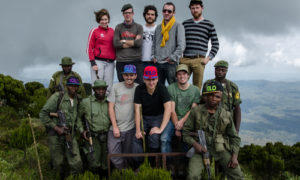 The border patrols and coordination with the local communities have ensured that the locations of any intruders in the park are known and action taken. The area of Bukavu is secured by the UN Mission in Congo (MONUSCO) and government forces.
The border patrols and coordination with the local communities have ensured that the locations of any intruders in the park are known and action taken. The area of Bukavu is secured by the UN Mission in Congo (MONUSCO) and government forces.
It is difficult to recommend the best time to go and visit Kahuzi Biega National Park because the park is located in a region with vast rain forest. The months between January and February are believed to be relatively dry while May to October is a period with more rains. Tourists should visit the park expecting rain at any time of the year. The rainy season transforms the park into perfect green with a lot of food which migratory birds love. Gorilla trekking is also best done during the rainy season because the gorillas are less mobile as food is in plenty.
Things to do in Kahuzi-Biega National Park
There are some people who assume all tourism related activities occur in Virunga National Park. The Democratic Republic of Congo is a vast country with several National parks and reserves. Kahuzi-Biega National park is one of DR Congo’s hidden gems. It is a great park to visit and because it is less visited and remains relatively virgin with lush green forest, great mountainous landscape, lakes and rivers. Kahuzi Biega gives you a feeling of visiting a true African wilderness – Africa as it used to be. Most of the national parks in East and Southern Africa receive too many visitors and are no longer in their virgin state. The main things that attract tourists to the park are:-
Eastern Lowland Gorilla Tracking: Most tourists who go to Kahuzi-Biega National Park do so to spot Grauer’s gorillas. Eastern lowland gorillas are larger than the mountain gorillas. The specie is making one of its last stands here and faces the possibility of extinction. The census of 2013 discovered 145 individuals in the highland sector of the park, a great decline from the 600 first counted in 1990. Grauer’s gorillas face threats from poaching (young gorillas for trade), illegal cutting down of trees, encroachment on land for farming and mining coltan. Three Grauer’s lowland gorilla groups are fully habituated and open to tourists in the highlands. Tracking the gorillas involves hiking though the dense tropical rain forests, swamps and even highlands depending on the last location of the gorilla group. While tracking the gorillas, it is important to listen to the instructions of the rangers at all times. Tracking can take anywhere between thirty minutes to 6 hours. You are only allowed one hour with the gorillas. Use this time to observe the family keenly. You should be able to spot juveniles playing, females nursing the young ones and the dominant silverback looking out for any danger to the family. You should also be able to identify the different individuals, personalities and group dynamics. By the end of the activity you will realize just how similar human beings are with gorillas and the more reason why we should protect them at all costs. Permits for gorilla tracking cost $400.
Nature Walks: The Park now has well established trails that take you to see the primates and birds. These are the same trails used for tracking the gorillas and border patrols by the park rangers. In the company of experienced park guides you can use the Marais Musisi Trail or use the Tshibati Waterfalls 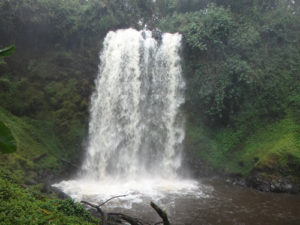 Trail that go through swamps, bamboo forests and 3 beautiful waterfalls. Watch out for primates like chimpanzee and small monkeys. Nature walks cost about $35.
Trail that go through swamps, bamboo forests and 3 beautiful waterfalls. Watch out for primates like chimpanzee and small monkeys. Nature walks cost about $35.
Mountain hiking: Hiking up to the summit of Mount Kahuzi offers breathtaking views of the town of Bukavu and Lake Kivu. Reaching the summit (3,308 meters) takes about four hours while climbing down takes three hour. Why climbing and descending, you will bypass sub-alpine vegetation and bamboo forests filled with birds and other creatures. Mount Biega is 2790 meters high and it takes about six hours to climb up and down the mountain. The vegetation spotted while climbing up mount Biega is quite different from that found in Mount Kahuzi. Another mountain suitable for hiking is Mount Bugulumiza. At 2400 m high it offers great views of the surrounding landscape including the mountains Biega and Kahuzi as well as the vast tropical rain forests of the park. Climbing up and down the mount Bugulumiza takes 3 hours. Climbing each mountain costs $100.
Birdwatching: There are morning and evening birding schedules to spot species like the African green broad bill, Congo peafowl and yellow crested helmet-shrike among others. Bird-watching can be done during the forest and nature walks.
Visiting the Lwiro Primate Rehabilitation Centre: This centre is close to the park headquarters. The Centre takes care of chimpanzees and other small primates that have lost their parents mainly due to poaching. This centre offers opportunities to volunteer and learn about primates and their conservation.
How to get to the park
Before traveling to Kahuzi Biega National Park, one needs to acquire a Congo Visa. The Visa costs about $115. Apart from Identification documents, Visa and park entrance fees, one will also need an invitation from the park to be allowed inside. This is a different procedure from that followed by parks outside DR Congo. The volatile situation in the Eastern part of the country has led to stringent security measures to protect the park, its officials and tourists. Crossing to Congo is also strictly supervised compared to Uganda, Rwanda or Kenya. The best way to cross the border is to arrange your tour with a tour company. If you are alone you need to move with an individual known to the Congolese border officials.
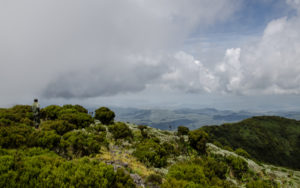 The best route is travel to Kahuzi-Biega is from Kigali to Congo using the border of Cyangungu and then to the town of Bukavu. Most international tourists land at Kigali Airport in the afternoon or evening. It is important to rest for the night and head for Bukavu the next day because the driving time from Kigali to the Congo border is seven hours. Travelers from Burundi can use the Uvira border and those arriving through Goma can use the Lake Kivu road. The Uganda route involves entering Rwanda at the Cyanika border and then resting for the night in Musanze before heading to Bukavu the next day. The road from Bukavu to the park entrance in Tshivanga is good and one can use a bus, taxi or hire a car.
The best route is travel to Kahuzi-Biega is from Kigali to Congo using the border of Cyangungu and then to the town of Bukavu. Most international tourists land at Kigali Airport in the afternoon or evening. It is important to rest for the night and head for Bukavu the next day because the driving time from Kigali to the Congo border is seven hours. Travelers from Burundi can use the Uvira border and those arriving through Goma can use the Lake Kivu road. The Uganda route involves entering Rwanda at the Cyanika border and then resting for the night in Musanze before heading to Bukavu the next day. The road from Bukavu to the park entrance in Tshivanga is good and one can use a bus, taxi or hire a car.
Transport by boat and air is also possible. The cost of the daily speed boat trip from Goma to Bukavu is about $50. The larger government owned boats cost between $8 to 25 dollars. It is important to book the tickets from ports in Goma and Bukavu at least a day in advance just to be sure. The airport in Goma has daily flights to Bujumbura, Rwanda and Entebbe in Uganda.
Packing List for Kahuzi Biega National Park
A safari in Africa needs good preparation and planning in order for it to be as comfortable and memorable as possible. As a developing country, some parts of the Democratic Republic of Congo have few good places where to acquire some of the essential things needed while on a safari. 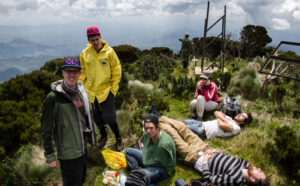 It is possible to get equipment in some of the towns like Bukavu and Goma but as a foreign traveler, locating the right outlet or shop may be difficult. We recommend that acquire all the important items or equipment before coming to Congo. There is no telecommunication network in Kahuzi-Biega national park as I write this article except in the main town of Bukavu. The internet used at the park office is got from a large satellite dish and is only available during the day. Some of the important things to pack during your safari in Kahuzi Biega are:
It is possible to get equipment in some of the towns like Bukavu and Goma but as a foreign traveler, locating the right outlet or shop may be difficult. We recommend that acquire all the important items or equipment before coming to Congo. There is no telecommunication network in Kahuzi-Biega national park as I write this article except in the main town of Bukavu. The internet used at the park office is got from a large satellite dish and is only available during the day. Some of the important things to pack during your safari in Kahuzi Biega are:
Adapters and batteries: For your laptop, phones and other telecommunication equipment. This will ensure that your devices are on throughout your time in the park. We recommend traveling with solar chargers for your devices if possible. You also need to acquire extra battery for any of your devices that cannot be recharged.
Bottled drinking water and light snack: Hiking the mountains or tracking the gorillas may wear you out causing thirst and hunger. To avoid this, it is recommended that you move with two bottles of drinking water and something light to eat in case you get hungry when an activity is prolonged.
Mosquito Repellents: Your hotel room will probably have a mosquito net but the parasites also bite outside the rooms and even in the jungles. Make sure you sleep under a mosquito net.
The right clothing: Kahuzi-Biega is a park with vast rain forests which bring rains throughout the year. There is a dry and wet season but the rains can surprise at any time and that is why it is important to travel with a rain jacket and warm clothing.
Medication: In case you have any medications prescribed by your doctor for any allergies or sickness, travel with them. The medical facilities in DR Congo are limited. Other medications to travel with include anti-diarrhea and pain killers. We advise that you take malaria pills two days before visiting East and Central Africa. You are required to present a yellow fever vaccination card before crossing over to DR Congo.
A camera: You don’t want to make history as the first visitor to move without a camera to capture the beautiful landscapes, animals and birds. The camera should be waterproof to be efficient in case of rains.
A Flashlight: There is no hydro-electricity in this part of the world and many of the hotels use solar panels or generators that can still go off and leave you in pitch darkness.
Toilet paper and towel: Sometimes the activity can go on for longer than expected and you might need to ease yourself in a makeshift hole in the African Jungle – come prepared.
A sleeping Bag and sheets: In case you are planning on camping or setting up a tent in one of the campsites, you will find a sleeping bag and two bed sheets handy. Camping costs $50 without a tent. The $50 is for the food and guards. A tent and sleeping bag can be hired each for $5 per night.
Lodges and Hotels – Accommodation in Kahuzi Biega National Park
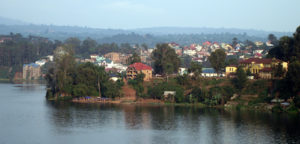 There are good hotels and lodges available while visiting Kahuzi-Biega National Park in Bukavu town. Tourists sleep in a hotel in Bukavu and head to the park early morning for activities. No hotels have been built in the park itself. Most of the hotels and lodges offer high quality services for budget, mid-range and high end rooms. Here are some of the hotels:-
There are good hotels and lodges available while visiting Kahuzi-Biega National Park in Bukavu town. Tourists sleep in a hotel in Bukavu and head to the park early morning for activities. No hotels have been built in the park itself. Most of the hotels and lodges offer high quality services for budget, mid-range and high end rooms. Here are some of the hotels:-
L’Orchids Safari Club: This is a luxury lodge built near the shores of the beautiful Lake Kivu. The serene and charming lakeside environment is very attractive to visitors. The hotel rooms are self-contained and very elegant offering a combination of African and contemporary designs. Visitors have a choice of both local and international food.
Coco Lodge Bukavu: This Lodge is built in the town of Bukavu which is near the park. There are 8 rooms that offer mid-range facilities. The rooms have both single and double beds that are furnished with African art, WiFi, televisions, hot/cold showers and toilets.
Hotel Begonias Bukavu: The hotels’ beautiful garden is the first thing that captures the attention of visitors. The rooms are excellent with friendly staffs that are on call day and night. The hotel offers a beautiful swimming pool for its residents.
Lake Side Hotel Bukavu: This is one of the standout hotels in Bukavu. The hotel is strategically built near Lake Kivu to give clients great views of the lake and its islands. Food is delicious and can be served at the restaurant or in the room.
Exodus Bukavu: This is a budget hotel built in the town center. It is perfect for visitors who wish to explore the small town before resting and heading out for activities in the park.
